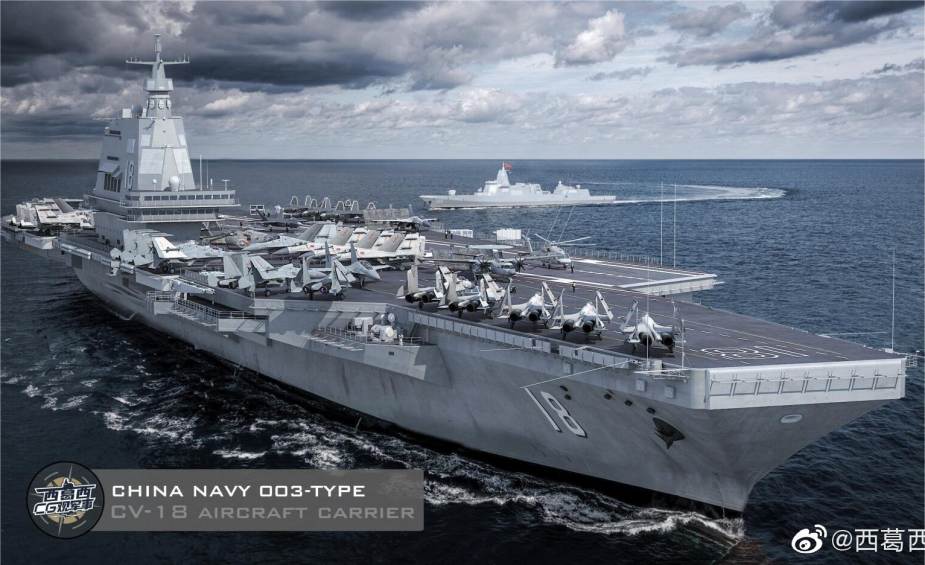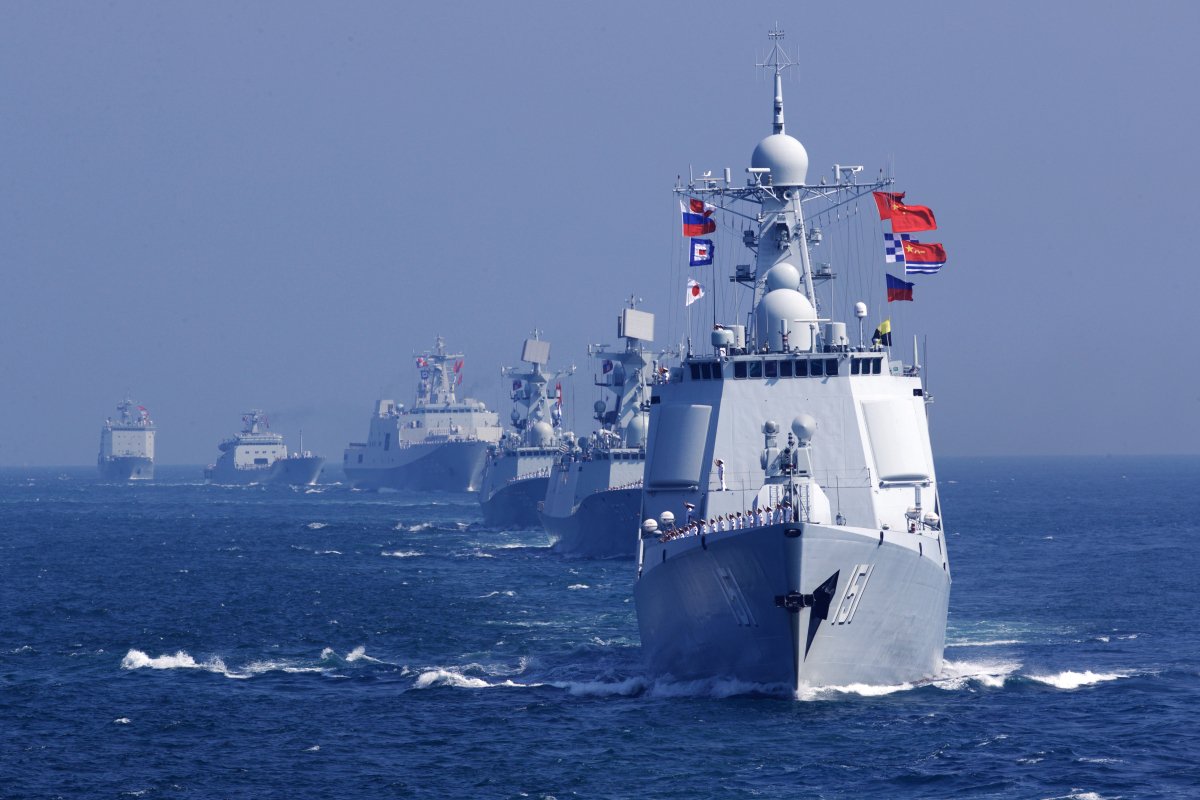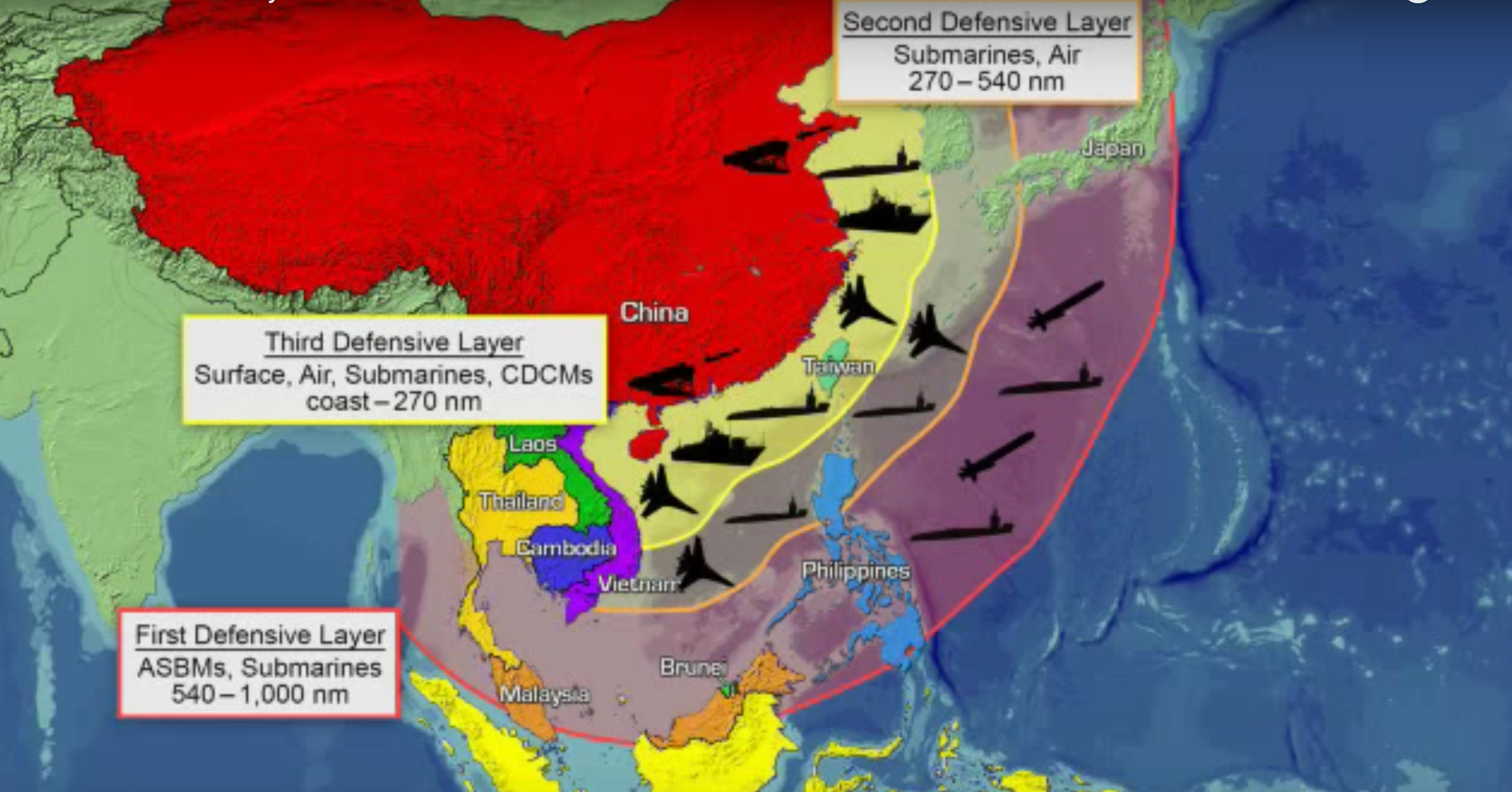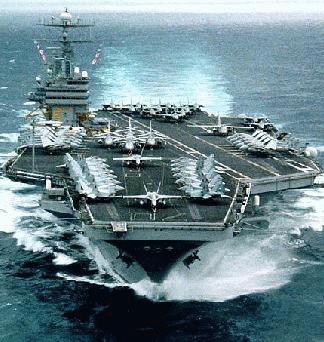
「反介入/區域拒止」(Anti-Access/Area Denial,A2/AD)為軍事術語,,簡單地說,就是一旦出現突發事件,當事其中一方迅速在事發區域劃定禁區,阻止第三方武裝干涉的能力。目前中國軍方正朝向A2/AD.前進定要成功實施A2/AD.於太平洋第一島鏈將美國擊敗,確保國家安全. .A2/AD projection is a series of overlapping capabilities across multiple domains like Air, Land, Sea, EW, Ai, Cyber and Space, with the sole aim of imposing maximum attrition on the adversaries’ war fighting capability in all spectrums
ANTI-Access/ Area- Denial (A2/AD), Why does it matter?: Like many of the metaphorical phrases emanating from the Western alliances, A2/AD — or anti-access and area denial — is primarily a new characterisation for an old way of war! From the invention of the English longbow to the development of the German Fritz-X guided anti-ship bomb, nations have mostly sought cost-effective means to deny access and inflict heavy losses on their foes.
Military thinkers have long cautioned that air forces and navies would encounter increasing difficulties in conducting operations in congested air defence setups and bathymetrically challenging littoral waters. During the Cold War, the United States understood any attempt to project its massive naval superiority in high seas against the Soviet coastal bastions might result in nightmarish levels of attrition. .
中國只需要3顆DF-26導向飛彈,就可以讓美國航空母艦在太平洋上變成名副其實的炭烤牛排.對號入座說形象一點,就是中國解放軍阻止美軍介入東海,台海,南海潛在軍事衝突,突破第一島鏈(日本、台灣、菲律賓等),以至威懾第二島鏈(關島,馬里亞納群島等),取得局部軍事優勢的能力。
中國解放軍反介入/區域拒止的具體手段,就是打擊美軍航母編隊,使其不敢輕易逼近中國周邊海域。包括台灣海峽.
Despite A2/AD being prevalent in current warfare doctrines, it is principally not a new threat. It is a mere logical consequence of the conventional arms and technology race which has been ongoing since the end of WWII. Simply put, A2/AD is the response to western force projection, precision strike, and highly-networked C2 capabilities over a period of time, which due regional adoption, possess a threat to a fragmented world order, where geopolitical economic measures need to be supported by a strong military presence. Enhanced capability, such as extended detection and engagement ranges in combination with high mobility, low detection probability, and networked redundancy, have created new defensive capabilities, that will govern the way war is fought in the coming decades..
 .
.
Red Star is at once succinct and expansive, accessible and erudite. Moreover, it is incredibly illuminating—the kind of book in which you will find yourself highlighting and writing notes in the margins. The authors don’t just admire the problem of China’s growing naval power; they explain how this power fits into China’s worldview and grand strategic design. They set out to tell us what Chinese leaders are doing and why. If you only have time to read one book about the challenge China poses to U.S. interests in the Pacific, make it this one.
Chain Reactions
To understand China’s actions in the South China Sea, we must first understand how China’s rulers view the region. This helps explain why America’s policy to “fly, sail, and operate anywhere international law allows” so irritates them.
China believes itself the victim of 150 years of repression that began in the 19th century. The Opium Wars left China humiliated, prostrate before foreign interlopers, resulting in national dismemberment. The ensuing century of humiliation (roughly 1839-1949) that followed left deep scars in the minds of Chinese strategists.[15] Former navy commander Wu Shengli counted no less than 470 invasions of Chinese territory during this period.
.China’s naval geography is framed around island chains that form natural chokepoints for maritime traffic. The first island chain, from China’s perspective, runs from the southern tip of Japan through the Ryukyu Islands and Taiwan, skirts the western Philippines, and wraps back around Vietnam. The second extends from central Japan through Guam to eastern Indonesia.
China often casts the island chain construct as Cold War relics, part of an “infrastructure of containment” built by America to keep China a second-rate power. It was, after all, U.S. Secretary of State Dean Acheson who in 1950 first referred to an American “defense perimeter of the Pacific.”[17] Douglas MacArthur, addressing Congress in 1951, stated that it was this “chain of islands” that would enable America to “dominate with sea and air power every Asiatic port and prevent any hostile movement into the Pacific.”[18] So, it is not without reason that China’s leaders view these islands as ramparts defended by hostile prison guards. Red Star makes a compelling argument that all of China’s maritime actions must be viewed through this lens.

However, much of the China’s rapidly maturing reconnaissance-strike complex and bristling array of missiles, especially the potent DF-21D and DF-26 ASBM, are aimed at intercepting the United States Navy’s renowned Carrier Battle Groups (CBGs), thousands of kilometres away from the Chinese mainland, as well as threatening the US forces in Guam.
Are Aircraft Carriers Still Relevant?
The debate over the centrality of the aircraft carrier in fleet structure continues unabated over 70 years since it came of age during World War II. The discourse over the decades – and this picked up steam in recent years – has been that anti-access/area-denial (A2/AD) weaponry like submarines and missiles, or even drone swarms in the future, will dethrone the “Queen of the Waves” from her exalted position.
Much of the debate focuses on how dangerous these threats are to the carrier. There is some basis to these arguments based on historical examples, but the main limitation is that these threats have not been truly proven in real-world combat. And of course, nobody has ever attacked a flat-top of any nation since World War II. Therefore, the literature on the so-called “carrier-killers” is based largely on informed speculation. Moreover, there are credible counters to them, as Dr. Robert Farley, a regular voice in the carrier debate as well as a frequent contributor to The Diplomat, correctly pointed out in an article on the Foxtrot Alpha defense blog. Another, more nuanced, look at this issue is perhaps in order.
.
換句話說,即使中國解放軍仍然無法在遠洋航母對航母,艦隊對艦隊般跟美軍較量,卻有把握擊傷甚至擊沉周邊海域的美軍航母戰鬥群,而只要美軍不敢前來,就會失去對這個地區的控制權。美軍猛增開支應付大國競爭,就是要避免這種情況成真。
中國DF-26導向飛彈與096SSBN.095SSN.核子潛艦,搭配北斗軍事衛星24小時的監控與打擊,卻也只能制標不制本,至少不會讓美國的航空母艦打擊群CBG接近中國附近的海域耀武揚威.
.
2019北約定軍事戰略專家分析指出,中國與美國雙方,在所謂A2/AD的戰略佈署重點,已由西太平洋轉移至中國南海及印度洋,因為中國海軍早已突破美國第一島鏈的控制,基本上西太平洋早已失守,中國突破美國第二島鏈的控制,只是遲早的事情,一般而言會在2030年時期左右,因為要等到中國海軍核子動力航空母艦CVN20.CVN21,正式服役,中國才有實力進入第2島鏈的區域與美國對抗.
.由來已久中國全面向西發展,推動一帶一路的建設與開發,奪取更多的戰略資源,這才是令美國擔心害怕的前瞻計劃,中國偉大的A2/AD也就是如此,至今為止,全世界尚未能徹底瞭解中國的全球戰略計劃,其實就是OROB一帶一路,因為反時針的運行,恰如其分,恰到好處的是反對向操作得利,美國無法有效力阻止中國的一帶一路開發計劃,隨者時間無止盡的延伸,中國愈來愈強,美國則是愈來愈弱,非常明顯的戰略計劃,中國以龜兔賽跑的哲理打敗美國最終贏得勝利.中國以七分經濟建設,三分軍事對抗美國,是絕對的正確,以時間換取空間的控制權,這樣一來中國穩贏的朝向,世界第一強國進. 中國南海及印度洋才是A2-AD的戰略重點
.
An area denial weapon or Anti Access/Area Denial (A2/AD) is a device or a strategy used to prevent an adversary from occupying or traversing an area of land, sea or air. The specific method used does not have to be totally effective in preventing passage (and sometimes is not) as long as it is sufficient to severely restrict, slow down, or endanger the opponent. Some area denial weapons pose long-lasting risks to anyone entering the area, specifically to civilians, and thus are often controversia.
Though A2/AD’s popularity may well be justified, it also has its critics all over the strategy think tanks. However, for all its possible criticisms and shortcomings, the concept can help us better understand the unfolding global competition for military access and movement in an increasingly mature precision-strike context. Hence, the growing availability of increasingly potent A2/AD capabilities poses a serious threat to the ability to deploy and employ forces into many theaters around the world.  .
. .
.
美國壓榨台灣購買美國2手淘汰型的破舊武器充當門面.在關鍵時刻卻是出賣台灣,一走了之如此而已.
美國無奈的無所適從,以優勢的軍事武力,包圍與遏阻中國的發展,都已為時太晚,無法與中國做長期的對峙. .
A2/AD — MUTATION & REGIONAL ADOPTION
The link between the development of these military systems by revisionist powers and their adoption of several destabilising security policies to further their national aims, now appears increasingly self-evident. What is less frequently discussed, however, is how this century’s two major challengers to the Western dominated order, Russia and China, have deliberately strengthened mid-sized revisionist actors with advanced anti-access weaponry.
In some cases, the motivation may be to ensure an embattled ally’s survival, as when Russia shields the Syrian regime of Bashar Al-Assad behind a dense umbrella of advanced, integrated air defense systems (IADS). In others, forming a material sub-component of a wider regional strategy, like when China supplies Pakistan with large numbers of HQ-16 and possibly the HQ-9 SAMs (HQ-9/ FD-2000 talks are underway), to take on the potential of the Indian Air Force, WS-2 technology to develop the Nasr battlefield missiles with tactical nuclear weapons (TNW) to take on India’s Cold Start doctrine (CSD), mobile batteries of C-802 anti-ship cruise missiles (ASCMs) or the CM-400AKG supersonic air-launched cruise missiles designed to cripple Indian aircraft carriers and naval assets.
 1樓. little pink2023/03/25 10:46醒醒吧
1樓. little pink2023/03/25 10:46醒醒吧
美軍根本不需要靠航空母艦
第一島鏈都是美軍基地_(littlepink@gmail.com)























